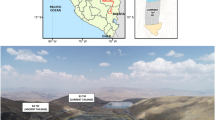Abstract
The Savannah River Site produced weapons-grade materials for nearly 35 years between 1953 and 1988. The legacy of this production is nearly 37 million gallons of radioactive waste. Since the 1950s, the liquid waste has been stored in large, underground carbon steel waste tanks. During the past 20 years, the site has begun to process the waste so that it may be stored in vitrified and grout forms, which are more suitable for long-term storage. Over the history of the site, some tanks have experienced leakage of the waste to the secondary containment. This article is a review of the instances of leakage and corrosion degradation that the tanks and associated equipment have experienced since the first tanks were built. Furthermore, the activities that the site has taken to mitigate the degradation and manage the service life of the tank for its anticipated lifetime are reviewed.























Similar content being viewed by others
References
Section VIII of the American Society of Mechanical Engineers (ASME) Boiler and Pressure Vessel Code, Years 1949, 1952, 1956, and 1965.
B.E. Loper, Liquid Waste Tank Structural Design Concept, DPE-3477, June 21, 1977.
ASTM A285-52a T, Tentative Specification for Low and Intermediate Tensile Strength Carbon Steel Plates of Flange and Firebox Qualities, Issued May 1949, Revised, December 1949, September and December 1950, and February and September 1952.
G.R. Caskey, Potential Radiation Damage—Storage Tanks for Liquid Radioactive Waste, WSRC-TR-92-350, August, 1992.
R.S. Ondrejcin, Chemical Compositions of Supernates Stored in SRP High Level Waste Tanks, DP-1347, August 1974.
R.S. Ondrejcin, Composition and Corrosiveness of Low-Activity Waste Supernates Stored at the Savannah River Plant, DP-1427, October 1976.
J.R. Fowler, Composition of F-Area Soluble High-Level Waste, DPST-82-390, March 10, 1982.
J.R. Fowler, Composition of H-Area Soluble High-Level Waste, DPST-82-502, April 28, 1982.
D.T. Hobbs, Supernatant Liquid Sampling in Waste Tanks (U), WSRC-RP-92-1179, September 23, 1992.
J.A. Stone, J.A. Kelley, and T.S. McMillan, Sampling and Analyses of SRP High-Level Waste Sludges, DP-1399, August 1976.
J.R. Fowler, Sludge Composition for Each Tank and DWPF Feed Batches, DPST-84-556, June 11, 1984.
M.L. Hyder, J. Phys. Chem. 69, 1858 (1965).
D. Chew, September 2013 WCS Curie and Volume Inventory Report, SRR-LWP-2013-00066, October 2013.
M.L. Holzworth, R.M. Girdler, L.P. Costas, and W.C. Rion, Mater. Prot. 7, 36 (1968).
W.L. Poe, Leakage from Waste Tank 16: Amount, Fate, and Impact, DP-1358, November 1974.
J.A. Donovan (Paper presented at the Conference on Environmental Degradation of Engineering Materials, Blacksburg, VA, October 1977).
R.S. Ondrejcin (Paper presented at the ASTM Symposium on Stress Corrosion Cracking, Toronto, Canada, May 1977).
H. Mazille and H. Uhlig, Corrosion 28, 427 (1972).
J.A. Donovan, Materials Aspects of SRP Waste Storage—Corrosion and Mechanical Failure, DP-1476, November 1977.
R.S. Ondrejcin, Salt Removal Compositional Limits—Suggested Technical Standard for Types I, II, and IV Nuclear Waste Tanks, DPST-83-533, July 25, 1983.
A.K. Agrawal, W.N. Stiegelmeyer, and W.E. Berry, Stress Corrosion Cracking Evaluation of ASTM A537 Steel in Simulated Radioactive Waste Solution at 180°C From Batelle Columbus Laboratories to E. I. Dupont, January 19, 1983.
B.J. Wiersma and K.H. Subramanian, J. Nucl. Mater. Manag. 41 (2013).
R.S. Ondrejcin, Prediction of Stress Corrosion of Carbon Steel by Nuclear Process Liquid Wastes, DP-1478, August 1978.
J.A. Donovan, R.S. Ondrejcin, and A.A. Kishbaugh, Relative Resistance to Nitrate Cracking of A537 Class I and A516 Grade 70 Normalized Steels, March 23, 1977.
J.A. Donovan, Resistance of Type A-537 Class I Steel to Nitrate Stress Corrosion Cracking, DPST-81-687, September 18, 1981.
K.H. Subramanian, Vapor Corrosion Response of Low Carbon Steel Exposed to Simulate High Level Radioactive Waste, WSRC-TR-2005-00508, Rev. 0, January 26, 2006.
K.H. Subramanian, Review of Type I High Level Waste Tank Ultrasonic Inspection Data, WSRC-TR-2003-00560, December 2003.
K.H. Subramanian and P.E. Zapp (Paper presented at CORROSION/2003, NACE International, Houston, TX, 2003), Paper No. 03676.
K.H. Subramanian and J.I. Mickalonis, Electrochim. Acta 50, 2685 (2005).
K.H. Subramanian and B.J. Wiersma (Paper presented at CORROSION/2006, NACE International, Houston, TX, 2006), Paper No. 06637.
K.H. Subramanian and B.J. Wiersma, High Level Waste Tank Farm Vapor Space Corrosion Program Zero-Step Implementation, SRNL-MTS-2006-00078, Rev. 0, June 12, 2006.
R.S. Ondrejcin and E.J. Majzlik, Galvanic and Crevice Corrosion of Pitted Waste Tanks: Review of A. D. Little Task 1 Interim Report Part 1, DPST-81-207, January 14, 1981.
R.S. Ondrejcin, Pitting of New Nuclear Waste Tanks Galvanic Corrosion of Primary Liner, DPST-81-410, May 6, 1981.
R.S. Ondrejcin and D.A. Mezzanotte, Mechanism of Waste Tank Pitting, DPST-81-591, July 21, 1981.
R.L. Sindelar and B.J. Wiersma, SRS High Level Waste Tank and Piping Systems—Structural Integrity Program and Topical Report, WSRC-TR-95-0076, June 1995.
B.J. Wiersma, Cooling Coil Failure Rates in Type I, II, and III Waste Tanks From 1970–92 (U), SRT-MTS-92-3118, December 4, 1992.
R.S. Ondrejcin, Investigation of Cooling Coil Corrosion in Radioactive-Waste Storage Tanks, DP-1425, January 1977.
S.P. Springer, Tank 16 Cooling Coil Sections, 200-H Area Metallurgical Report, February 8, 1979.
B.J. Wiersma, Measurement of the Ductile to Brittle Transition Temperature for Waste Tank Cooling Coils (U), WSRC-TR-92-444, September 1992.
B.J. Wiersma, Investigation of the Corrosion Behavior of Cooling Coil Material in a Simulated Concrete Environment, WSRC-TR-93-078, February 1, 1993.
B.J. Wiersma and M.S. Shurrab, A Visual Assessment of the Concrete Vaults which Surround Underground Waste Storage Tanks (U), WSRC-TR-93-761, December 1993.
R.S. Ondrejcin, Inhibitors in Nuclear Waste Tank Cooling Coils (U), WSRC-TR-91-37, January 18, 1991.
C.F. Jenkins, Vapor Leak Repair, Tank 38H, 200-F&H Area Metallurgical Report, June 3, 1982.
C.F. Jenkins, Defective Cooling Coil, Tank 43, 200-F&H Area Metallurgical Report, August 5, 1980.
C.F. Jenkins, Defective Cooling Coil, Tank 44, 200-F&H Area Metallurgical Report, January 12, 1982.
Author information
Authors and Affiliations
Corresponding author
Rights and permissions
About this article
Cite this article
Wiersma, B.J. The Performance of Underground Radioactive Waste Storage Tanks at the Savannah River Site: A 60-Year Historical Perspective. JOM 66, 471–490 (2014). https://doi.org/10.1007/s11837-014-0870-x
Received:
Accepted:
Published:
Issue Date:
DOI: https://doi.org/10.1007/s11837-014-0870-x




